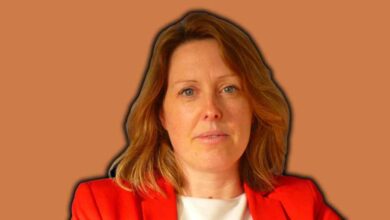Beth Cullen-Kerridge: The Fearless Sculptor Redefining Modern British Art

Beth Cullen-Kerridge stands as one of Britain’s most thought-provoking sculptors, a creative force who merges raw craftsmanship with profound social commentary. Her work embodies a perfect balance of strength, vulnerability, and rebellion. Through marble, bronze, and stone, Cullen-Kerridge creates more than just sculptures—she creates conversations. Her journey, from a young art student in Liverpool to an internationally acclaimed artist with works displayed across London and Dubai, reflects not only her mastery of form but also her fierce independence and willingness to challenge conventions.
Early Life and Family Background
Beth Cullen-Kerridge was born in 1970 in Stoke-on-Trent, a city deeply connected to craftsmanship and ceramics. Art was not a distant concept in her family—it was a way of life. Her father, James Cullen, was a painter, and her mother, Judith Vincent, was a successful businesswoman. Growing up in an environment that valued both creativity and determination, Beth developed a sharp eye for beauty and detail from an early age.
Stoke-on-Trent, often referred to as “The Potteries,” offered a strong sense of industrial creativity that would later echo in her sculptures. Surrounded by clay, kilns, and craftsmanship, Beth’s surroundings infused her with an appreciation for materials and texture. It is perhaps no surprise that she went on to work with some of the most tactile and enduring materials in art—bronze, marble, and stone.
Education and Artistic Formation
Cullen-Kerridge studied Fine Art at John Moores University in Liverpool, where she laid the foundation for her artistic identity. She later pursued a Master’s degree in Sculpture at the Royal College of Art (RCA), London—an institution known for producing some of the UK’s leading contemporary artists. At the RCA, she refined her technical skills and began developing her signature visual language, blending figurative realism with bold abstraction.
Her early exposure to British sculptural traditions, particularly those championed by artists like Sir Anthony Caro and Eduardo Paolozzi, shaped her understanding of scale, form, and space. But Cullen-Kerridge’s approach quickly diverged from her mentors. She was less interested in academic perfection and more drawn to the emotion and psychological tension embedded in human experiences.
Apprenticeship and Early Career
Before fully establishing herself, Beth worked as an assistant to several leading sculptors, including Eduardo Paolozzi, Sir Anthony Caro, and Elisabeth Frink. These experiences were invaluable. They not only honed her technical expertise in casting, welding, and carving but also exposed her to the realities of sustaining a career as a working artist.
Her collaborations with Anthony Caro, in particular, were pivotal. She participated in large-scale projects involving architect Sir Norman Foster, such as installations for the Millennium Bridge and works shown at the Venice Biennale. Through these collaborations, Cullen-Kerridge learned how sculpture could interact with architecture, environment, and public space—an idea that would define much of her later work.
The Artistic Philosophy
Beth Cullen-Kerridge’s sculptures are more than aesthetic statements—they are deeply introspective explorations of human emotion and societal pressure. She often portrays the tension between external appearance and internal truth, using corporate symbols like suits, ties, and shirts as metaphors for conformity and identity.
Her acclaimed “Empty Suit” series exemplifies this. Cast in bronze and often oversized, these hollow garments symbolise the loss of individuality in modern corporate culture. By removing the human body and leaving only the shell of clothing, she questions the value systems that define success, power, and identity in contemporary society.
Cullen-Kerridge’s work often balances masculinity and femininity—power and fragility coexist. Her sculptures suggest that vulnerability can be strength, that art can simultaneously critique and celebrate human ambition.
Notable Works and Public Installations
Beth Cullen-Kerridge’s portfolio includes both intimate gallery pieces and monumental public commissions. One of her most recognisable works is Dhow Sail, a striking marble sculpture installed outside the Dubai Opera House. Its sweeping curves not only echo the traditional sails of the Arabian Gulf but also serve as functional seating, demonstrating how beauty and utility can coexist in public art.
Another significant piece, Boardroom Sacrifice, installed in London’s Canary Wharf, embodies her commentary on the price of ambition. Cast in bronze, the work captures the emotional cost of success, a theme that resonates with the modern workforce.
Her Four Plinths installation at Brown Hart Gardens in Mayfair further solidified her status as a sculptor unafraid to engage with corporate themes in a poetic yet confrontational way. Whether placed in the heart of London’s business district or displayed in international exhibitions, her works invite reflection and provoke discussion.
A Pause for Life and Business
In the mid-2000s, Beth took an unexpected turn in her career. Alongside her husband, celebrity chef Tom Kerridge, she helped establish The Hand & Flowers, a gastropub in Marlow, Buckinghamshire, which later became the first pub in the UK to receive two Michelin stars.
This period marked a pause in her sculptural production, but it was far from an artistic retreat. Running a business gave her a new perspective on balance, discipline, and the intersection between creativity and entrepreneurship. Eventually, the urge to return to the studio became irresistible.
Return to Sculpture and Renewed Vision
Around 2010, Beth Cullen-Kerridge returned to full-time sculpture, this time with renewed focus and emotional depth. She travelled to Carrara, Italy—the home of Michelangelo’s marble—to immerse herself in the purest form of material mastery. Working directly with marble, she rediscovered the meditative rhythm of carving, which reconnected her to the roots of classical sculpture while reinforcing her contemporary message.
This period also led to some of her most personal and powerful works, blending elegant craftsmanship with complex emotional undercurrents. Her sculptures began appearing in exhibitions around the world, from London to New York and Dubai.
Style and Materials
Cullen-Kerridge’s artistic style can be described as both modern and timeless. Her preference for bronze and marble reflects her respect for traditional sculptural materials, but her forms and subjects remain entirely contemporary.
Her surfaces are often polished to perfection, yet they retain a tactile rawness. This deliberate contrast mirrors her themes—society’s obsession with surface-level perfection versus the rough truth beneath. She often creates fragmented figures or objects, symbolising disconnection and the human need for wholeness.
Awards and Recognition
Beth Cullen-Kerridge’s contributions to the art world have earned her numerous accolades. She received the Global Art Award for Sculpture in 2017, a recognition that celebrated her innovation and influence on modern sculpture. Her alma mater, the Royal College of Art, has also recognised her as one of its notable alumni, reflecting her enduring impact on British cultural life.
Her work is represented by several prestigious galleries and private collections worldwide. Exhibitions such as Hard Rock, Heavy Metal in 2025 at TW Fine Art, West Palm Beach, further demonstrate her ongoing relevance and international appeal.
Personal Life and Inspirations
Beth is married to Tom Kerridge, one of the UK’s most popular and respected chefs. The couple met in the early 1990s and share a son, Acey. Their partnership is a blend of artistic and culinary creativity, grounded in mutual respect and shared values.
Beth has often spoken about the challenges of balancing motherhood, marriage, and an artistic career. She sees these experiences as integral to her creative process. Her sculptures often channel emotions from her own life—moments of doubt, determination, and resilience.
The Legacy of Beth Cullen-Kerridge
Beth Cullen-Kerridge’s legacy lies in her ability to merge physical form with psychological depth. Her sculptures are not simply admired—they are felt. She represents a new generation of British sculptors who refuse to conform to trends, instead carving out a space defined by authenticity and courage.
Through her work, she invites audiences to confront uncomfortable truths about ambition, gender, and identity. Her art is a mirror—sometimes flattering, sometimes challenging, but always honest.
Influence on Modern British Art
In an age dominated by digital art and ephemeral installations, Cullen-Kerridge’s commitment to traditional materials stands out. Yet, her themes—capitalism, emotional strain, societal masks—are entirely modern. This fusion of old and new is what makes her work timeless.
She also serves as an inspiration for young artists who seek to merge art and life authentically. Her career shows that success does not mean abandoning one’s individuality, and that true artistry lies in perseverance and conviction.
Conclusion
Beth Cullen-Kerridge’s journey from the pottery town of Stoke-on-Trent to the global art stage is a story of resilience, mastery, and meaning. Her sculptures, carved from stone yet filled with emotion, continue to redefine how contemporary art can speak to modern life.
She reminds us that art is not merely decoration—it is reflection, rebellion, and revelation. Whether through the polished curves of marble or the haunting emptiness of a bronze suit, Beth Cullen-Kerridge gives form to the invisible struggles and triumphs of human existence.



